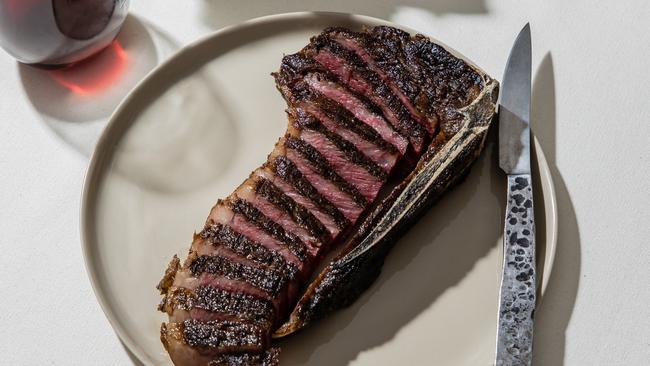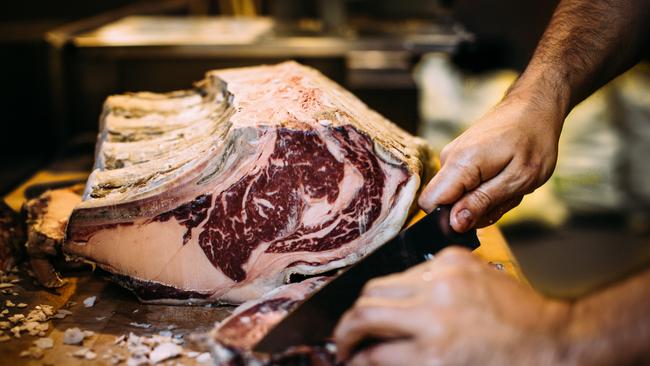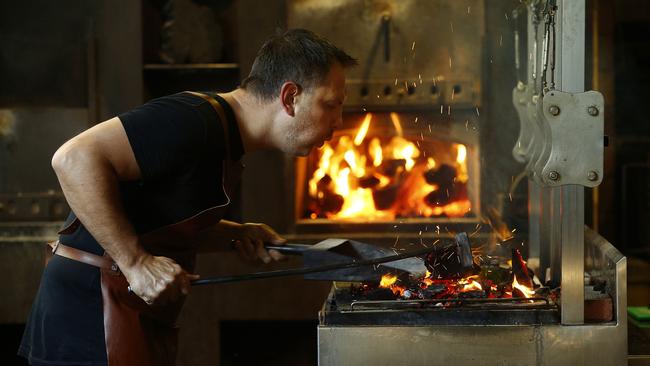How to cook steak
Grass or grain fed? Which cut is best? Acclaimed chef and firemaster Lennox Hastie goes back to the elements.

Of all the questions I am asked, the most frequent is, “How can I cook the perfect steak?” If the combination of meat and fire is as old as time, then the quest to cook the perfect steak may well be the Holy Grail. There are so many personal preferences and possibilities that it has become quite a divisive subject. Is grass or grain fed better? Which cut is best? Should I pre-season or season on the grill? Trouble is, a cow can be one of many breeds or a mix, and such a big animal can be broken down into myriad cuts.
Here’s a guide to chew over.

Should you use grain or grass-fed beef?
This boils down to the flavour you enjoy most. Grass-fed beef has a rich, beefy flavour. However, it can often be leaner, making it sensitive to overcooking, which renders it dry and unpalatable. Grass-fed accepts nature on its own terms, so it’s a bigger gamble – you never know whatyou will get. At its best, nothing can compare.In contrast, grain-fed is all about the fat and how it weaves through the muscles in the meat (“marbling”). This crazy paving of fat relates not only to the breed and its genetic disposition but also to the special diet on which the animal is “finished”. Special feed recipes create incredible flavour and quality which at its highest level has fat that melts in your mouth like butter.
How long should meat be aged?
The ageing of meat is a natural process of decomposition during which enzymatic reactions tenderise meat fibres and create a spectrum of flavour. While there are many different forms of ageing meat, the most common are “wet”, where the cuts are cold stored under vacuum in a bag, or “dry”, where the meat is left to openly dry at a controlled temperature and humidity. Both create a strikingly different result.
While wet ageing occurs anaerobically, allowing lactobacilli bacteria to grow and create lactic acid producing sour, cultured dairy notes, dry ageing means meat is left to breathe, removing the moisture that restricts bacterial growth and encouraging a party of beneficial mould, intensifying the earthy flavours and complexity with notes of nuts, mushrooms, even cheese. I have aged beef from 100 days to more than 300 days, discovering new flavours including toasted popcorn, foie gras, dry sherry, hazelnuts, black truffle and even parmesan. While these flavours might not be for everyone, I recommend choosing beef aged for at least six to eight weeks as it has an improved flavour and texture. If you don’t know what you are doing, leave it to someone who has the space, time and conditions in which to control the process.

What is the best cut?
As a rule of thumb, the less-worked muscles are more tender. Conversely, the more-worked muscles will be more flavoursome, as will anolder animal whose muscles are more developed. There is a lot to be said for respecting your elders but this is only true for those cows that are loved and looked after, and looking after a cow can be costly and time-consuming.
There are a myriad names bestowed upon many parts of the animal, depending on the country of origin and whether it is on or off the bone. Rump or rib, scotch or skirt, tri-tip or T-bone, bavette, chuck-tail, flat-iron or karubi plate are some of the options. It can be confusing to navigate so I recommend you explore and find the one that suits you. Sourcing great meat starts with developing a relationship with a good butcher or local farmer, who should be able to guide you in relation to the meat and the various cuts they have available. It can often be daunting to begin with but I entreat you to give it a go, engage in conversation and ask questions. If they are not interested, you are in the wrong place.
Meat is a treat to be savoured, so always go for quality over quantity and buy the best steak you can afford. Animal first, cut second – if you’re on a budget, think about buying a cheaper cut such as bavette or rump from a higher-quality producer rather than buying a fillet or a rib-eye that is substandard. I don’t eat steak every night, choosing to save and splurge on a great piece of meat once a month rather than eat an average steak that hasn’t been treated with respect.
While a rib-eye might be the choice of many, it can be too fatty and a fillet is rarely going to satisfy in terms of flavour, as tender as it might be. Consider the sirloin – a cut once so well regarded it was said to have been knighted by royalty. It rides a balanced wave between flavour and texture and is straightforward to cook on the grill. My preference is to cook it on the bone, as the rigid structure makes it easier to handle while also creating more flavour.
There are several ways to cook a steak, but for me you cannot beat the natural flavour from when it is cooked over the embers of a wood fire. Meat, fire, salt are the key ingredients. And if you’ve stuck to the principles above, they should be all you need.

-
RECIPE: The perfect steak
A 700g steak is about right for two. Remove your steak from the fridge and allow it to come to room temperature – this allows the fat to melt, the exterior to caramelise instead of char, and for the meat to cook evenly.
Ingredients
- Your steak of choice, bone-in
- Coarse sea salt
- Olive oil
- Butter
Method by fire or barbeque
- Light your fire, burning your wood or charcoal down to hot embers, or light your barbecue. Alternatively, heat a heavy based frying pan to high medium-heat on the stove. Ideally your grill should be approximately 10cm above the embers.
- Hold the steak by the bone and brush the fat across the grill rack three or four times to season the grill. Place the steak on the grill and immediately season well with good coarse sea salt, adjusting the height or heat of the grill or the embers as necessary to ensure that the steak is only being licked by flames. Season liberally – at the beginning, during, and at the end.
- Grill for 5-6 minutes, moving the steak frequently to avoid bar marks but allowing the surface to caramelise to a rich mahogany.
- Turn the steak and season again. Continue to grill for a further 3-4 minutes. Remove the steak from the grill and allow to rest in a warm place for 8-10 minutes.
Method by frypan
- Heat a large heavy-based frying pan to medium-high heat on the stove. Place the steak on the fat side/edge and allow to render for 1 minute. Add 20ml of olive oil and carefully lay the steak on its side and immediately season well with good coarse sea salt.
- Add a small knob of butter and pan-fry for 5-6 minutes to a rich mahogany.
- Turn the steak and season again. Add another knob of butter and continue to pan fry for a further 2-3 minutes, basting frequently.
- Remove the steak from the pan and allow to rest in a warm place for 8-10 minutes. With a sharp knife, remove the meat from the bone and carve into 8mm slices.
- Finish with a pinch of salt and serve immediately with a simple green salad.


To join the conversation, please log in. Don't have an account? Register
Join the conversation, you are commenting as Logout